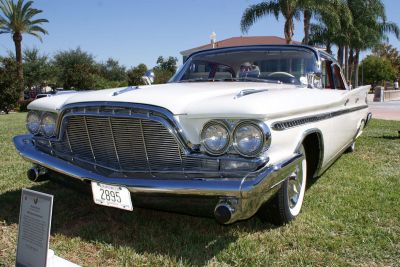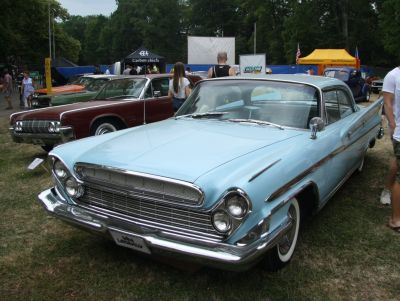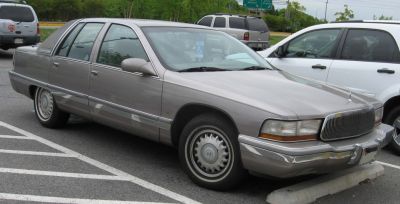 1960 DeSoto Adventurer I 4-Door HardTop Dimensions, Size & Specs
1960 DeSoto Adventurer I 4-Door HardTop Dimensions, Size & SpecsMeasurements of the 1960 DeSoto Adventurer I 4-Door HardTop, engineered for optimal performance and comfort
| Dimensions | |
|---|---|
| Length: | 5512 mm217.0 in18.1 ft |
| Width: | 2017 mm79.4 in6.6 ft |
| Height: | 1397 mm55.0 in4.6 ft |
| Ground Clearance: | 132 mm5.2 in0.4 ft |
| Trunk Capacity (Max): | 929 liter32.8 cu ft |
| Weight Specifications | |
| Curb Weight: | 1817 kg4006 lbs |
The 1960 DeSoto Adventurer I 4-Door HardTop is an iconic full-size sedan produced from 1959 to 1960. This classic American vehicle measures a substantial 5512 mm (217 inches) in length, offering generous interior space and a commanding road presence. With a width of 2017 mm (79.4 inches) and a low-profile height of 1397 mm (55 inches), the Adventurer I achieves an impressive combination of elegance and aerodynamic styling for its era. Weighing in at 1817 kg (4007 lbs) curb weight, this car delivers a solid and stable ride characteristic of large luxury sedans of the late 1950s and early 1960s.
One of the highlights of the DeSoto Adventurer I is its practical luggage capacity. With the rear seats folded down, the trunk volume expands to 929 liters (32.8 cubic feet), making it remarkably versatile for a vehicle of its generation. The ride height or ground clearance stands at 132 mm (5.2 inches), balancing enough clearance for varied road conditions with the sleek styling desired in a hardtop sedan.
The 1960 DeSoto Adventurer I 4-Door HardTop represents a prestigious blend of size, performance, and utility during a unique period in American automotive history. It remains a standout example of the era's full-size cars, combining spaciousness and classic styling with practical features such as ample luggage space and a comfortable ride height.
Discover the standout features that make the 1960 DeSoto Adventurer I 4-Door HardTop a leader in its class
Have a question? Please check our knowledgebase first.
The 1960 DeSoto Adventurer I 4-Door HardTop measures 5512 mm (216.9 inches) in length and 2017 mm (79.4 inches) in width. These large dimensions give the car a commanding road presence typical of American sedans from that era. The substantial length enhances rear passenger comfort and trunk space, while the wide body contributes to stable handling and a roomy interior. It represents the classic full-size sedan segment, designed for spaciousness and comfort rather than compact urban maneuverability.
The height of the 1960 DeSoto Adventurer I is 1397 mm (55.0 inches), with a ground clearance of only 132 mm (5.2 inches). The relatively low height contributes to a sleek hardtop profile without a central pillar, enhancing style and aerodynamics. However, the low ground clearance means cautious driving over speed bumps or uneven roads is necessary to avoid underbody scrape. Parking in places with low overhead clearance should generally pose no problem due to its moderate height.
This generation of the DeSoto Adventurer weighs approximately 1817 kg (4007 lbs) curb weight, which is typical for a large American 4-door sedan of its time. The heavier mass contributes to a stable and smooth ride but can impact acceleration and fuel economy negatively compared to lighter vehicles. The weight also points to solid construction, with ample sound deadening and steel body panels that enhance durability and passenger safety.
With rear seats folded down, the 1960 DeSoto Adventurer I offers a generous luggage capacity of 929 liters (approximately 32.8 cubic feet). This spacious cargo area greatly enhances the sedan’s practicality for road trips or transporting larger items. The capacity is generous for a sedan, reflecting the model’s focus on comfort and utility, making it suitable for families or those who require flexibility in carrying luggage or goods.
The DeSoto Adventurer I’s length of 5512 mm (216.9 inches) and width of 2017 mm (79.4 inches) places it on the larger side for today’s residential garages. Standard single garages are often about 2400 mm (94 inches) to 2700 mm (106 inches) wide and around 5400 mm (213 inches) long. So, the width might be a tight fit or require careful maneuvering, especially with mirrors. While it can fit in garages with sufficient space, owners should check dimensions to ensure accessibility and ease of parking.
Compared to the previous generation DeSoto Adventurer models, the 1960 Adventurer I maintained a similar full-size sedan footprint but grew slightly in length and width to offer more interior space and comfort. Although specific earlier generation dimensions vary by model year, this generation's length of 5512 mm and width of 2017 mm signify incremental increases aimed at enhancing spaciousness and road presence, which was a trend in late 1950s American sedans. The evolution focused more on sleeker styling and improved functionality than significantly changing the car's size category.
Compared to contemporaries like the 1960 Chrysler 300F and 1960 Buick Electra, the DeSoto Adventurer I’s dimensions were competitive but slightly varied. For example, the Chrysler 300F was roughly similar in length, between 5500 and 5600 mm, and similar in width around 2000 mm. Buick Electra models were comparable but sometimes a bit longer or heavier. The DeSoto holds a distinct position with its hardtop design delivering a slightly lower height and unique styling cues, balancing size and sporty elegance in its segment.
The hardtop design of the 1960 DeSoto Adventurer I means it has no fixed B-pillar between the front and rear doors, giving the cabin a more open and airy feel when windows are down. This design does not significantly affect the exterior dimensions but impacts interior space perception and accessibility. It also contributes to a sleek, coupe-like side profile, lowering visual height and improving aesthetics without sacrificing headroom, which remains comfortable due to the generous overall height of 1397 mm.
With a ground clearance of 132 mm (5.2 inches), the 1960 DeSoto Adventurer I sits quite low, which benefits vehicle stability, handling, and aesthetic appeal. However, it limits the car's capability over rough roads, speed bumps, or steep driveways. Drivers need to be cautious to avoid undercarriage damage. Also, the relatively low clearance may not be ideal in areas with heavy snowfall or poor road conditions, but it was typical and appropriate for American urban and suburban roads of its time.
The 1960 DeSoto Adventurer I’s large size (5512 mm length and 2017 mm width) and considerable curb weight (1817 kg) typically lead to lower fuel efficiency compared to smaller or lighter cars. In the 1960s, fuel economy was a less prioritized metric, especially for powerful American sedans equipped with large V8 engines. The substantial weight, while ensuring a smooth and solid ride, requires more engine power to accelerate and maintain highway speeds, contributing to higher fuel consumption. However, the trade-off is a comfortable, stable driving experience with luxury accommodations typical of the era.
Discover similar sized cars.

| Production: | 1958-1959 |
|---|---|
| Model Year: | 1959 |
| Length: | 5514 mm217.1 in |
| Width: | 1999 mm78.7 in |
| Height: | 1394 mm54.9 in |

| Production: | 1959-1960 |
|---|---|
| Model Year: | 1960 |
| Length: | 5512 mm217.0 in |
| Width: | 2017 mm79.4 in |
| Height: | 1397 mm55.0 in |

| Production: | 1960-1961 |
|---|---|
| Model Year: | 1961 |
| Length: | 5476 mm215.6 in |
| Width: | 2017 mm79.4 in |
| Height: | 1397 mm55.0 in |

| Production: | 1991-1996 |
|---|---|
| Model Year: | 1991 |
| Length: | 5483 mm215.9 in |
| Width: | 1984 mm78.1 in |
| Height: | 1421 mm55.9 in |
